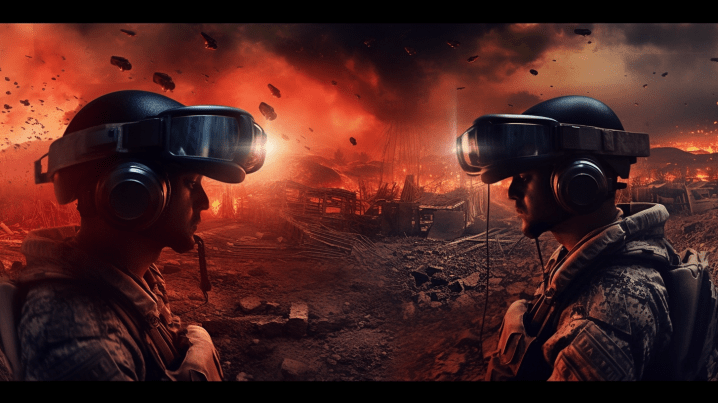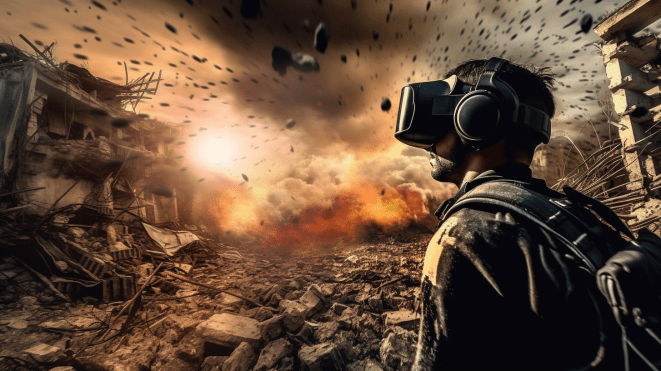Virtual Reality in military training enhances instruction and hones the soldiers’ skills.
One of the founding fathers of the United States, Benjamin Franklin, once remarked that if you don’t plan, you plan to fail. He always communicated key topics in a funny and straightforward manner.
Any general will acknowledge that each war requires a thorough strategy and years of planning.
Without all that planning and preparation, entering combat operations would be a disaster waiting to happen. There will undoubtedly be a horrible defeat for that regiment or unit.

The importance of training combat and support personnel in the military services cannot be overstated. To experience triumph on the battlefield, a well-trained, disciplined, and inspiring force is required.
The government of all nations are very advanced, and the use of cutting-edge technologies has strengthened their strategic and tactical advantages.
It has become very crucial to train everyone on these technologies if we want to have a fighting force that is completely effective. Traditional training methods face numerous difficulties, and new technologies have emerged to support total training requirements.
Virtual reality is now acknowledged as one of the most fascinating technologies that helps improve human potential and raise performance.
According to PWC, virtual reality (VR) learners learn 4 times more quickly and with 275% more confidence than traditional classroom learners. A remarkable discovery is the almost threefold rise in confidence, especially when people are required to make important choices.

Virtual reality is not unfamiliar to the younger generation; many have at least heard about it from friends or peers or have experienced it themselves. The military establishment is taking steps to incorporate virtual reality into military training programs as a result of realizing this.
The training of fresh recruits and cadets will benefit most from VR instruction. The boot camp itself needs to incorporate this kind of training.
Using VR, it is inexpensively possible to receive training on weapons and weapon systems, learn safe handling techniques, perform maintenance, develop situational awareness, and become proficient in all skill sets.
These synthetic training environments—also known as virtual reality scenarios—help the young soldier create a number of bloodless war scenarios. They are exposed to various terrains, simulated weather, and logistical difficulties that they would possibly face in actual combat circumstances.
Every military situation has the potential to be life or death, and only a highly skilled and qualified soldier can carry out the mission’s objectives under pressure.

The best armed forces in the world, including the US Army, have already realized this and are actively investigating the potential military uses for virtual reality. To create simulations and mission rehearsals for its troops, they are constantly contacting defense technology businesses.
Creating fighting situations and solutions for chemical, biological, and cyberwarfare scenarios would also be included. They have realized that virtual reality training reduces the cost of logistics and field training with live ammunition, and As VR instruction is available around-the-clock, there are no time limits.
The Integrated Moving Target Simulator, often known as the Stinger Training Dome, is a virtual reality training simulator used by the US Army. To train and improve the abilities of soldiers who must operate the army’s MANPADS, or man-portable air defense systems, this simulator offers a 360-degree battle scenario.
These are portable surface-to-air missiles that pose a severe danger to helicopters, unmanned aerial vehicles (UAVs), drones, low-flying aircraft, etc. Examples include the US Stinger, Russian Verba, Chinese QW-4, etc.
This training improves the soldier’s expertise and confidence in their ability to carry out the required combat operations in the actual theatre of battle. Not far behind is the Indian military apparatus.
Many non-military circumstances, such pandemics and climatic emergencies, frequently require the assistance of the military. They are frequently requested on short notice since civilian establishments find it difficult to handle them.
Virtual reality can be used to create training on these scenarios for all army personnel regarding emergency and catastrophe management. During national emergencies, the acquired abilities will have a significant impact on saving lives and reducing property damage.
In essence, militaries recognize the necessity to constantly be ready to address a nation’s security issues in light of today’s dynamic and complicated geopolitical environments.
It is possible to emphasize how important it is to keep ahead of the competition and anticipate enemy challenges. Intense training and regular competency and capability reviews help to enhance preparedness technologies, including VR is crucial to achieving those objectives.
For quick deployment, it is necessary to identify efficient use cases and develop solutions. The bottom line is that in order to develop such technological capabilities, technology businesses and VR solution suppliers need to actively collaborate with military commanders


